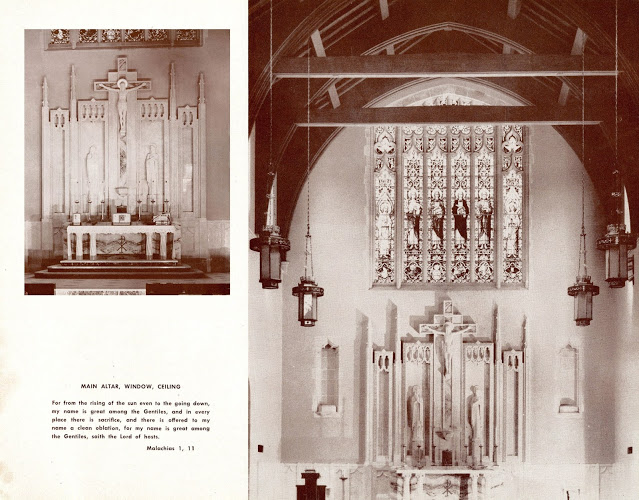I found more photos of St. Augustine’s Cathedral’s transformation, with the coveted, before:
After:
I have to say the first after wasn’t horrible but the after after is wonderful with two caveats. I don’t think the baldacchino was necessary and tends to clutter the sanctuary and confine the altar, although the new altar and tabernacle placement is an improvement over the before, before (original). I think things as they are without the baldacchino would have been perfect.
The second caveat is the bishop’s throne or cathedra. I like it except it is a bit to severe or big, especially its reredos. That could have been simpler. The ambo is a vast improvement and for cathedral’s in the correct side of the sanctuary (it was on the opposite side in the first after. I also love the “corona” over it. Splendid.
Here are even more photos of the renovation:
Before and After: St. Augustine's Cathedral in Kalamazoo, Michigan
 St. Augustine's Cathedral in Kalamazoo, Michigan, working in collaboration with the architectural firm of Duncan Stroik , recently completed the first phase of a renovation of that cathedral with the re-consecration/dedication of the cathedral taking place this past Gaud…
St. Augustine's Cathedral in Kalamazoo, Michigan, working in collaboration with the architectural firm of Duncan Stroik , recently completed the first phase of a renovation of that cathedral with the re-consecration/dedication of the cathedral taking place this past Gaud…


8 comments:
I was expecting to see statues in the niches on either side of the reredos. I agree that the baldachinno is unnecessary especially since the columns do not fit the gothic style.
If you look at the before, those empty niches are empty. The niches are removed or covered over in the after but reappear empty again in the after after. It is puzzling. Maybe they are awaiting the statues that never arrived for the original look???????? Very peculiar.
Well, it is Kalamazoo. So it could be the baldacchino has radiant heaters in it and the reredos have forced hot water.
According to the article they plan to put statues in the restored niches. Perhaps there was originally an intention to put statues in them but it never happened, though some early 20th Century gothic buildings I've seen use empty niches as a decorative feature.
Fr AJM,
Yes, the niches likely await statues that were never sponsored. There's a massive parish about 30 minutes from my home that is approximately 65 years old and only filled the niches on the front facade of their church about 15 years ago.
I have to agree with you, Fr., there's a lot of h-e-a-v-y fixtures in that sanctuary, perhaps too many. I honestly like the original high altar, it was representative of the era of construction (I'm guessing early 50s). Perhaps thematically recapturing the original appearance of the interior might have been the better solution. Stroik, thematically, includes a baldacchino in most of his designs. Anyhow, despite its quirks, what's there is there, it is by no means offensive and I doubt many will be yearning for another renovation to correct.
The ciborium magnum gives dignity to the main altar which if simply plonked in the middle of the sanctuary would be overwhelmed. There is no 'correct' side for an ambo. This one is more of a pulpit which traditionally would have been in the nave and used for the sermon. It even has a sounding board or tester.
One problem with the restoration of the ambo in the wake of Vatican II was that it was not seen as a worthy place for the proclamation of Scripture, but as a reading desk cum pulpit cum music stand.
Ten years or so ago I sang at a Solemn EF Mass in a modern church. Both Epistle and Gospel were sung at the ambo facing the people. This seemed to me at the time as quite appropriate.
Fr Uwe Michael Lang is of the opinion that the restoration of the ambo post-1965 obviated the need to celebrate versus populum. When the Epistle and Gospel had to be read at the altar the only way they could be read facing the people was to turn the altar round and celebrate the whole Mass in this orientation.
In any case, to put a 'corona' over the ambo and not over the altar suggests the primacy of the Word over the Sacrifice, which is protestant rather than Catholic.
I think that the baldachinno is needed, maybe a little less imposing, but needed, this particular sanctuary is quite deep and shares the same ceiling with the main body of the church. If the sanctuary was round, domed and set off with a presidium or archway I would agree it was not needed, but it tends to bring the altar forward and so it is not lost on such a large and flat wall.And on the plus side the window is not obstructed very much. I do find the reappearances of the niches interesting, i wonder if they were covered up or had to be replaced ?
Now about that altar rail???
Post a Comment